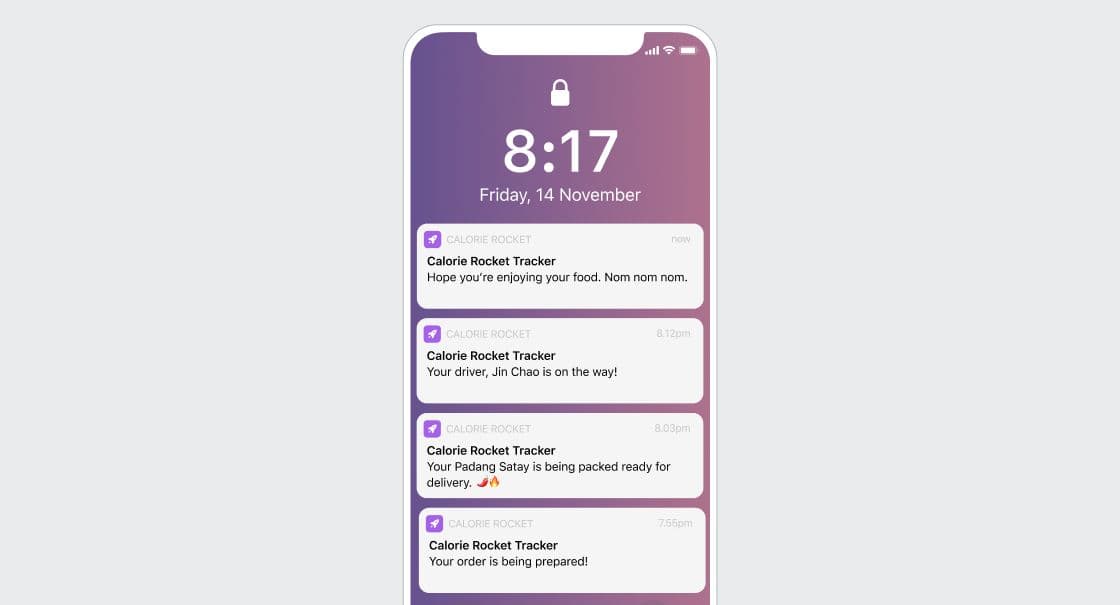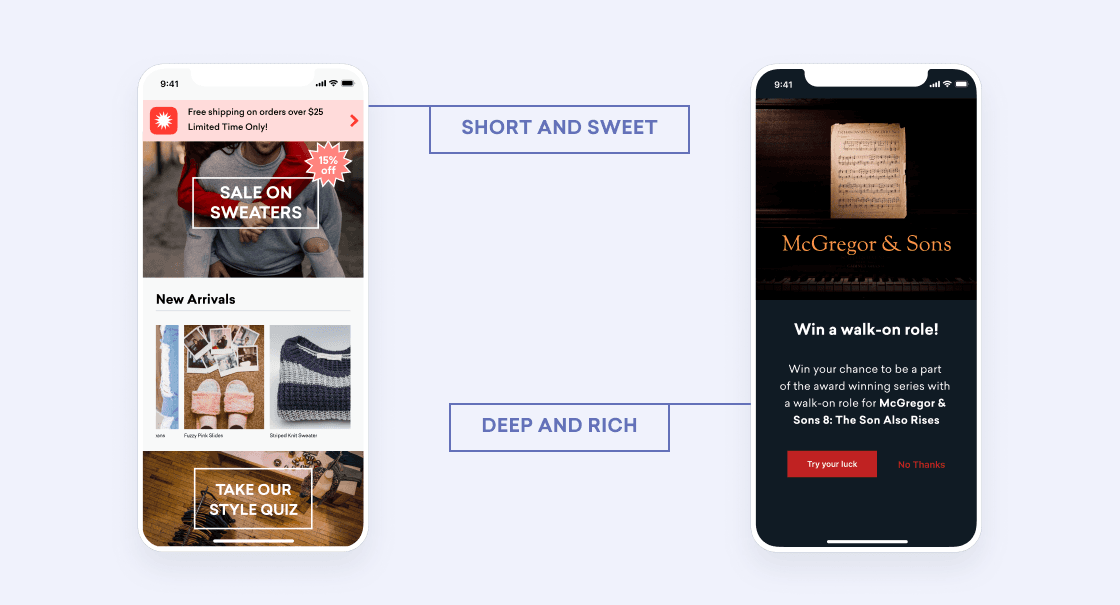What’s the Difference Between Push Notifications and In-App Messages?
Published on November 19, 2020/Last edited on November 19, 2020/5 min read


Adam Swiderski
WriterSpeaking about mobile messaging as if it's a single, monolithic entity is a mistake too many marketers today make. The truth is, there are multiple ways to reach consumers in the mobile space, and even within each of those mobile channels, there are channel-specific benefits, complications, and use cases that need to be understood if one is planning a comprehensive messaging strategy.
Where should you start? By ensuring you understand the differences between push notifications and in-app messaging (IAM). While these two mobile messaging channels might seem similar at first blush, there are several key differences that marketers need to understand before they can build out smart, effective messaging campaigns on mobile. So let’s dive in and discover the differences between push notifications and IAM.
Push Lives Where You Don't
Push notifications are short, catchy messages that can be seeded out to anyone who is opted in to receive them. While early push messages were only capable of delivering plain text, they’ve really come of age in recent years, and modern push messaging is a much richer experience that can involve imagery, video, and interactive features, allowing for a greater range of use cases and possible user responses. Now, instead of—for example—simply letting customers know about a sale, brands can showcase the products on offer and provide customers a way to engage directly through their smartphone, web browser, or wearable device.

There are pluses and minuses that come with the ability to initiate contact with consumers on such high-touch channels. On one hand, it can be a powerful means of just-in-time contact, while also sustaining relationships over the long haul by keeping a brand front-of-mind for customers. With that great power, however, comes great responsibility, and it's important to note that push messaging blasts and one-size-fits-all campaigns in this channel can annoy rather than engage, triggering opt-outs and uninstalls. As such, it's important to approach push with an eye toward when and how consumers want to be reached.
IAM Is More Than Meets the Eye
In contrast to push notifications, IAMs exist within the confines of a brand’s mobile app. Highly versatile and customizable, this channel can easily mirror the look and feel of an app or web site, thereby creating a seamless, organic-feeling messaging experience that can do everything from onboarding new users to showcasing features within a brand’s digital presence that a given customer has been neglecting.

At first blush, it might seem like the fact that IAMs only exist within the confines of a mobile or wearable application is a weakness, but there’s a flip side to that limitation. It means that IAMs reaches consumers who’ve already cleared the first hurdle toward engagement—they’re actively interacting with your brand. Whether they’re new customers interested in learning more about a brand or long-time power users, they’re already primed to receive messaging, and creative use of IAM can dramatically enhance their experience right where they are.
Two Messaging Types Enter, One Messaging Strategy Leaves
So, when it comes to drawing contrast between push notifications and IAMs, the first answer is also the most obvious one. Both require a degree of opt-in, whether it's actively enabling the channel (iOS push) or downloading and installing an app (IAM and Android push), but one (push) reaches consumers when they are not directly engaged with a brand, while the other (IAM) lives in an environment with which consumers have to actively interact in order to receive them. The fact of the matter is, push notifications and IAMs bring to bear different strengths, and can work in a complementary fashion.
Since push is highly visible on phones, watches, and computers, the odds are good that a message sent in this channel will be seen by its recipient. That makes push particularly useful for re-engaging with customers who may have lapsed in their interaction with a brand, increasing chances at retention. IAMs, meanwhile, provides an opportunity to connect with an engaged audience and to drive them to make purchases or take other key actions by utilizing tailor-made messaging. Whether the goal is to convey urgent information via something short and sweet or deliver a more complex, in-depth experience that’s as rich as email, IAM has you covered.
Of course, the upshot is that, while it can be useful to understand the differences between push and in-app messaging, it's not necessary to choose between them when crafting a marketing strategy. In fact, one of the key elements of both is the way in which they work best within a comprehensive cross-channel messaging plan. Imagine that your brand has a news app with a big feature story to promote. You could leverage push notifications to let users know that the story has been published...and then, when they open the app and finish reading the story, you could serve up an IAM to direct them to other content they’re likely to find interesting or to nudge them to sign up for your email newsletter. Embracing this kind of approach can really pay off: When push is paired with in-app messages, for instance, users engaged at a rate 224% higher than individuals who were targeted for push messages alone.
What's Next?
Understanding the ways that push notifications and IAMs fit into the jigsaw puzzle that is a comprehensive cross-channel marketing effort is imperative to making sure you're getting the most out of your mobile marketing channels. And achieving that understanding is best accomplished by taking a hard look at the data around the ways in which users receive and react to them. If you're ready for that step, check out the Cross-Channel Data Report and learn how you can put push and in-app messaging to work.
Related Tags
Be Absolutely Engaging.™
Sign up for regular updates from Braze.
Related Content
View the Blog
How AI Decisioning Transforms Marketing (A Complete Guide)

Team Braze

AI decisioning cheat sheet: How to crawl/walk/run with BrazeAI Decisioning Studioᵀᴹ

Team Braze

A day in the life of a data scientist on the BrazeAIᵀᴹ forward-deployed engineering team
